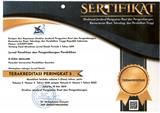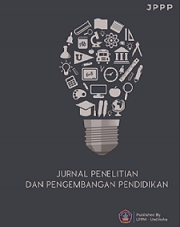Heat E-Teaching Material Assisted by Augmented Reality and CTL Model to Promote Students' 4C Skills
DOI:
https://doi.org/10.23887/jppp.v8i2.66837Keywords:
Electronic Teaching Materials, Heat, Augmented Reality, CTL Models, Critical Thinking, Creative ThinkingAbstract
The 21st century requires students to adapt and utilize the growing sophistication of technology. The expected 21st century learning is 4C skills to face global challenges. Students' critical thinking and creative thinking skills in physics learning are still low. The solution to the problem is that students need more interactive teaching media in order to increase interest in learning, digital teaching materials with Augmented Reality integrated CTL models are the solution to the problem. The purpose of this study was to determine the needs analysis, validity and practicality of using digital teaching materials with AR integrated with CTL models to improve students' critical and creative thinking skills. This type of research is Research and Development with the Hannafin and Peck development model. Data collection instruments include needs analysis instruments, validation questionnaire sheets and practicality questionnaire sheets. The data analysis techniques used are descriptive, qualitative, and quantitative statistics. Based on the data analyzed, there are three research results. First, the results of needs analysis research which stated that students' critical and creative thinking was still low. Second, the results of product validation with the valid category. Third, the results of product practicality with a very practical category. It is concluded that electronic teaching materials for heat assisted by Augmented Reality and CTL models can be used in learning. Research implications, with electronic teaching materials assisted by AR CTL model, teachers are expected to be able to motivate, guide and direct students in building 4C skills.
References
Afni, N., & Hartono. (2020). Contextual teaching and learning (CTL) as a strategy to improve students mathematical literacy. Journal of Physics: Conference Series, 1581(1). https://doi.org/10.1088/1742-6596/1581/1/012043. DOI: https://doi.org/10.1088/1742-6596/1581/1/012043
Agusti, R. H., Nasir, M., & Islami, N. (2023). Implementation of Contextual Teaching and Learning Based Physics Module on Newton’s Law Material to Improve Critical Thinking Skills of Class X Students. Journal of Education and Learning Research, 1(1), 8–19. https://doi.org/10.62208/jelr.1.1.p.8-19. DOI: https://doi.org/10.62208/jelr.1.1.p.8-19
Al-Adwan, A. S., Albelbisi, N. A., Hujran, O., Al-Rahmi, W. M., & Alkhalifah, A. (2021). Developing a holistic success model for sustainable e-learning: A structural equation modeling approach. Sustainability (Switzerland), 13(16), 1–25. https://doi.org/10.3390/su13169453. DOI: https://doi.org/10.3390/su13169453
Alenezi, A. (2020). The role of e-learning materials in enhancing teaching and learning behaviors. International Journal of Information and Education Technology, 10(1), 48–56. https://doi.org/10.18178/ijiet.2020.10.1.1338. DOI: https://doi.org/10.18178/ijiet.2020.10.1.1338
Almazroa, H., & Alotaibi, W. (2023). Teaching 21st Century Skills: Understanding the Depth and Width of the Challenges to Shape Proactive Teacher Education Programmes. Sustainability (Switzerland), 15(9). https://doi.org/10.3390/su15097365. DOI: https://doi.org/10.3390/su15097365
Almulla, M. A. (2020). The Effectiveness of the Project-Based Learning (PBL) Approach as a Way to Engage Students in Learning. SAGE Open, 10(3). https://doi.org/10.1177/2158244020938702. DOI: https://doi.org/10.1177/2158244020938702
Ana, A. J., Suarti, S., Rasyid, R., & Mariani, S. (2022). the Effect of the Contextual Teaching and Learning (Ctl) Learning Model Based on Simulation Media on the Motivation and Learning Outcomes of Students in Physics Learning. Journal of Teaching and Learning Physics, 7(2), 88–96. https://doi.org/10.15575/jotalp.v7i2.17116. DOI: https://doi.org/10.15575/jotalp.v7i2.17116
Anderson, T., & Rivera-Vargas, P. (2020). A critical look at educational technology from a distance education perspective. Digital Education Review, 37, 208–229. https://doi.org/10.1344/DER.2020.37.208-229. DOI: https://doi.org/10.1344/der.2020.37.208-229
Asfar, A. muhammad irfan taufan, Asfar, A. M. I. A., Trisnowali, A., Dahlan, J. A., Prabawanto, S., & Nurannisa, A. (2023). Validity and Practicality of Learning Model Development of LAPS-Heuristics with Local Wisdom on Students’ Metacognitive Ability. Jurnal Penelitian Dan Pengembangan Pendidikan, 6(3), 492–499. https://doi.org/10.23887/jppp.v6i3.51990. DOI: https://doi.org/10.23887/jppp.v6i3.51990
Asrizal, A., Annisa, N., Festiyed, F., Ashel, H., & Amnah, R. (2023). STEM-integrated physics digital teaching material to develop conceptual understanding and new literacy of students. Eurasia Journal of Mathematics, Science and Technology Education, 19(7). https://doi.org/10.29333/ejmste/13275. DOI: https://doi.org/10.29333/ejmste/13275
Asrizal, A., Mardian, V., Novitra, F., & Festiyed, F. (2022). Physics electronic teaching material-integrated STEM education to promote 21st-century skills. Cypriot Journal of Educational Sciences, 17(8), 2899–2914. https://doi.org/10.18844/cjes.v17i8.7357. DOI: https://doi.org/10.18844/cjes.v17i8.7357
Asrizal, Amran, A., Ananda, A., Festiyed, F., & Sumarmin, R. (2018). The development of integrated science instructional materials to improve students’ digital literacy in scientific approach. Jurnal Pendidikan IPA Indonesia, 7(4), 442–450. https://doi.org/10.15294/jpii.v7i4.13613. DOI: https://doi.org/10.15294/jpii.v7i4.13613
Bugg, N. (2020). Teaching critical thinking skills. Radiologic Technology, 68(5), 433–434. https://doi.org/10.4324/9780429342042. DOI: https://doi.org/10.4324/9780429342042
Cahyati, S. S., Tukiyo, T., Saputra, N., Julyanthry, J., & Herman, H. (2022). How to Improve the Quality of Learning for Early Childhood? An Implementation of Education Management in the Industrial Revolution Era 4.0. Jurnal Obsesi : Jurnal Pendidikan Anak Usia Dini, 6(5), 5437–5446. https://doi.org/10.31004/obsesi.v6i5.2979. DOI: https://doi.org/10.31004/obsesi.v6i5.2979
Coman, C., Țîru, L. G., Meseșan-Schmitz, L., Stanciu, C., & Bularca, M. C. (2020). Online teaching and learning in higher education during the coronavirus pandemic: Students’ perspective. Sustainability (Switzerland), 12(24), 1–22. https://doi.org/10.3390/su122410367. DOI: https://doi.org/10.3390/su122410367
Divayana, D. G. H., Suyasa, P. W. A., Ariawan, I. P. W., Mahendra, I. W. E., & Sugiharni, G. A. D. (2019). The Design of Digital Book Content for Assessment and Evaluation Courses by Adopting Superitem Concept Based on Kvisoft Flipbook Maker in era of Industry 4.0. Journal of Physics: Conference Series, 1165(1), 0–6. https://doi.org/10.1088/1742-6596/1165/1/012020. DOI: https://doi.org/10.1088/1742-6596/1165/1/012020
Du, R., Turner, E., Dzitsiuk, M., Prasso, L., Duarte, I., Dourgarian, J., Afonso, J., Pascoal, J., Gladstone, J., Cruces, N., Izadi, S., Kowdle, A., Tsotsos, K., & Kim, D. (2020). DepthLab: Real-time 3D interaction with depth maps for mobile augmented reality. UIST 2020 - Proceedings of the 33rd Annual ACM Symposium on User Interface Software and Technology, 829–843. https://doi.org/10.1145/3379337.3415881. DOI: https://doi.org/10.1145/3379337.3415881
Elvisa, G. O., & Rifai, H. (2021). The validity of the science edupark E-Book with a scientific approach based on Padang Beach tourism destinations. Journal of Physics: Conference Series, 1876(1). https://doi.org/10.1088/1742-6596/1876/1/012059. DOI: https://doi.org/10.1088/1742-6596/1876/1/012059
Ghonivita, Y., Pahamzah, J., Murti, S., Wijayanti, A., & Ageng, S. (2021). Improving Students’ Listening Skill and Vocabulary Masteryn Through Contextual Teaching and Learning (Ctl) By Using Online Learning for Senior High School. International Journal of English Language and Linguistics Research, 9(4), 45–55. DOI: https://doi.org/10.48181/jelts.v4i1.10557
Goh, E., & Sigala, M. (2020). Integrating Information & Communication Technologies (ICT) into classroom instruction: teaching tips for hospitality educators from a diffusion of innovation approach. Journal of Teaching in Travel and Tourism, 20(2), 156–165. https://doi.org/10.1080/15313220.2020.1740636. DOI: https://doi.org/10.1080/15313220.2020.1740636
Gómez-Galán, J. (2020). Media education in the ICT Era: Theoretical structure for innovative teaching styles. Information (Switzerland), 11(5), 1–17. https://doi.org/10.3390/INFO11050276. DOI: https://doi.org/10.3390/info11050276
Hakim, L. (2018). Pengembangan Media Pembelajaran Pai Berbasis Augmented Reality. Lentera Pendidikan : Jurnal Ilmu Tarbiyah Dan Keguruan, 21(1), 59–72. https://doi.org/10.24252/lp.2018v21n1i6. DOI: https://doi.org/10.24252/lp.2018v21n1i6
Hamzah, M. L., Ambiyar, Rizal, F., Simatupang, W., Irfan, D., & Refdinal. (2021). Development of Augmented Reality Application for Learning Computer Network Device. International Journal of Interactive Mobile Technologies, 15(12), 47–64. https://doi.org/10.3991/ijim.v15i12.21993. DOI: https://doi.org/10.3991/ijim.v15i12.21993
Harjono, A., Andani, T. G., Gunada, I. W., & Susilawati, S. (2022). Implementation of Blended-Flipped Classroom Model Assisted by Video to Improve Students’ Creative Thinking Skills. Jurnal Penelitian Pendidikan IPA, 8(6), 3180–3186. https://doi.org/10.29303/jppipa.v8i6.2255. DOI: https://doi.org/10.29303/jppipa.v8i6.2255
Heilporn, G., Lakhal, S., & Bélisle, M. (2021). An examination of teachers’ strategies to foster student engagement in blended learning in higher education. International Journal of Educational Technology in Higher Education, 18(1). https://doi.org/10.1186/s41239-021-00260-3. DOI: https://doi.org/10.1186/s41239-021-00260-3
Hulaimi, A. (2019). Strategi Model Pembelajaran Contextual Teaching and Learning (CTL). Jurnal Tarbawi, 4(1), 76–92. DOI: https://doi.org/10.29103/relativitas.v1i1.1197
Hyun, C. C., Wijayanti, L. M., Asbari, M., Purwanto, A., Santoso, P. B., Igak, W., Bernarto, I., & Pramono, R. (2020). Implementation of contextual teaching and learning (CTL) to improve the concept and practice of love for faith-learning integration. International Journal of Control and Automation, 13(1), 365–383.
Inaya, D. F., & Setiyawati, E. (n.d.). Analysis of Students ’ Creative Thinking Ability in Class V Elementary School Science Learning [ Analisis Kemampuan Berpikir Kreatif Siswa Dalam Pembelajaran IPA Kelas V Sekolah Dasar ]. 1–8.
Istyadji, M., Yulinda, R., Amalina, D., & Fahmi. (2022). Validity and Practicality of Articulate Storyline Learning Media on Environmental Pollution Materials for Junior High School Students. Jurnal Penelitian Pendidikan IPA, 8(6), 2599–2604. https://doi.org/10.29303/jppipa.v8i6.1639. DOI: https://doi.org/10.29303/jppipa.v8i6.1639
Iwan, M., & Suyatna, A. (2018). DEVELOPMENT OF STATIC FLUID LEARNING PROPS TO IMPROVE STUDENTS ’ ARGUMENTATION SKILLS. International Journal of Research -GRANTHAALAYAH, 6(6), 296–309. https://doi.org/10.29121/granthaalayah.v6.i6.2018.1374. DOI: https://doi.org/10.29121/granthaalayah.v6.i6.2018.1374
Kennedy, G. M. (2023). Challenges of ICT Integration in Teachers’ Education: A Case Study of the College of Education, University of Liberia. International Journal of Social Science and Education Research Studies, 03(05). https://doi.org/10.55677/ijssers/v03i5y2023-15. DOI: https://doi.org/10.55677/ijssers/V03I5Y2023-15
Khahro, S. H., & Javed, Y. (2022). Key Challenges in 21st Century Learning: A Way Forward towards Sustainable Higher Educational Institutions. Sustainability (Switzerland), 14(23). https://doi.org/10.3390/su142316080. DOI: https://doi.org/10.3390/su142316080
Khalim, A. (2023). Strategi Pembelajaran Contextual Teaching and Learning. Jurnal Ilmu Pendidikan Islam, August.
Khasani, R., Ridho, S., & Subali, B. (2019). Identifikasi Kemampuan Berpikir Kritis Siswa SMP Pada Materi Hukum Newton. Jurnal Penelitian Pendidikan IPA, 5(2), 165–169. https://doi.org/10.29303/jppipa.v5i2.192. DOI: https://doi.org/10.29303/jppipa.v5i2.192
Kingsley, N. U., & Ugwu, P. (2019). The Concept and Application of ICT to Teaching/Learning Process. International Research Journal of Mathematics, Engineering and IT, 6(2), 10–22.
Kwangmuang, P., Jarutkamolpong, S., Sangboonraung, W., & Daungtod, S. (2021). The development of learning innovation to enhance higher order thinking skills for students in Thailand junior high schools. Heliyon, 7(6), e07309. https://doi.org/10.1016/j.heliyon.2021.e07309. DOI: https://doi.org/10.1016/j.heliyon.2021.e07309
Marlina, W., & Jayanti, D. (2019). 4C dalam Pembelajaran Matematika untuk Menghadapi Era Revolusi Industri 4.0. Prosiding Sendika, 5(1), 392–396.
Matthew, U., Kazaure, J., & Okafor, N. (2018). Contemporary Development in E-Learning Education, Cloud Computing Technology & Internet of Things. EAI Endorsed Transactions on Cloud Systems, 7(20), 169173. https://doi.org/10.4108/eai.31-3-2021.169173. DOI: https://doi.org/10.4108/eai.31-3-2021.169173
Meitiyani, M., Elvianasti, M., Maesaroh, M., Irdalisa, I., & Amirullah, G. (2022). Analysis of Students Creative Thinking Ability in Environmental Problem Solving. AL-ISHLAH: Jurnal Pendidikan, 14(2), 1983–1994. https://doi.org/10.35445/alishlah.v14i2.1629. DOI: https://doi.org/10.35445/alishlah.v14i2.1629
Nida, R., M, A. S., & Haryandi, S. (2021). Pengembangan Bahan Ajar Elektronik Berbasis Multimodel pada Materi Alat-Alat Optik untuk Melatihkan Kemampuan Analisis Peserta Didik. Jurnal Ilmiah Pendidikan Fisika, 5(2), 107. https://doi.org/10.20527/jipf.v5i2.2871. DOI: https://doi.org/10.20527/jipf.v5i2.2871
Nurhalimah, S., Selfa, S. K., Amanda, U., & Ilmi, D. (2024). Penguatan Pendidikan Peserta Didik Melalui Keterampilan 4C dengan Mengimplementasikan Pembelajaran Abad 21 dalam Pembelajaran Pendidikan Agama Islam. Al-Tarbiyah: Jurnal Ilmu Pendidikan Islam, 2(1), 239–249. DOI: https://doi.org/10.59059/al-tarbiyah.v2i1.799
Nurhasnah, N., Kasmita, W., Aswirna, P., & Abshary, F. I. (2020). Developing Physics E-Module Using “Construct 2” to Support Students’ Independent Learning Skills. Thabiea : Journal of Natural Science Teaching, 3(2), 79. https://doi.org/10.21043/thabiea.v3i2.8048. DOI: https://doi.org/10.21043/thabiea.v3i2.8048
Nurhayati, I., Pramono, K. S. E., & Farida, A. (2024). Keterampilan 4C (Critical Thinking, Creativity, Communication And Collaboration) dalam Pembelajaran IPS untuk Menjawab Tantangan Abad 21. Jurnal Basicedu, 8(1), 36–43. https://doi.org/10.31004/basicedu.v8i1.6842. DOI: https://doi.org/10.31004/basicedu.v8i1.6842
Nurkhodri, M., & Dafit, F. (2022). Development of Powerpoint-Based Interactive Media on Theme 8 Subtheme 1 in Elementary School. Jurnal Penelitian Dan Pengembangan Pendidikan, 6(2), 329–339. https://doi.org/10.23887/jppp.v6i2.51217. DOI: https://doi.org/10.23887/jppp.v6i2.51217
Ramdani, S. D., El Islami, R. A. Z., Pratiwi, H., Fawaid, M., Abizar, H., & Maulani, I. (2021). Developing digital teaching material on Basic Electricity based on problem-based learning in vocational education. Jurnal Pendidikan Vokasi, 11(1), 78–91. https://doi.org/10.21831/jpv.v11i1.38894. DOI: https://doi.org/10.21831/jpv.v11i1.38894
Rasmitadila, Widyasari, Prasetyo, T., Rachmadtullah, R., Samsudin, A., & Aliyyah, R. R. (2021). General teachers’ experience of the Brain’s natural learning systems-based instructional approach in inclusive classroom. International Journal of Instruction, 14(3), 95–116. https://doi.org/10.29333/iji.2021.1436a. DOI: https://doi.org/10.29333/iji.2021.1436a
Reeve, J., & Shin, S. H. (2020). How teachers can support students’ agentic engagement. Theory into Practice, 59(2), 150–161. https://doi.org/10.1080/00405841.2019.1702451. DOI: https://doi.org/10.1080/00405841.2019.1702451
Risan, R., Hasriani, H., & Muhayyang, M. (2021). The Implementation of CTL Method in teaching English to the students of MAN 1 Enrekang. Language Circle: Journal of Language and Literature, 16(1), 125–136. https://doi.org/10.15294/lc.v16i1.31158. DOI: https://doi.org/10.15294/lc.v16i1.31158
Rodrigues, A. L., Cerdeira, L., Machado-Taylor, M. de L., & Alves, H. (2021). Technological skills in higher education—different needs and different uses [Habilidades tecnológicas en la educación superior: necesidades y usos diversos]. Education Sciences, 11(326), 1–12. https://doi.org/10.3390/ educsci11070326. DOI: https://doi.org/10.3390/educsci11070326
Samsudin, A., Raharjo, T. J., & Widiasih. (2023). Effectiveness of Contextual Teaching Learning (CTL) and Problem Based Learning (PBL) Models in Class VI Science Subjects on Creativity and Learning Outcomes. Jurnal Penelitian Pendidikan IPA, 9(11), 9324–9331. https://doi.org/10.29303/jppipa.v9i11.5290. DOI: https://doi.org/10.29303/jppipa.v9i11.5290
Saxena, N. (2017). the Role and Impact of Ict in Improving the Quality of. International Journal of Engineering Sciences & Research Technology The, 6(3), 501–503.
Sayaf, A. M., Alamri, M. M., Alqahtani, M. A., & Al-Rahmi, W. M. (2021). Information and communications technology used in higher education: An empirical study on digital learning as sustainability. Sustainability (Switzerland), 13(13). https://doi.org/10.3390/su13137074. DOI: https://doi.org/10.3390/su13137074
Sugiyarti, L., & Arif, A. (2018). Pembelajaran Abad 21 di SD. Prosiding Seminar Dan Diskusi Nasional Pendidikan Dasar, 439–444.
Sugiyono. (2019). Quantitative qualitative research methods and R&D. Alphabet.
Sumardi, L., Rohman, A., & Wahyudiati, D. (2020). ImplementasikPembelajarankTematikiSiswaoKelasiRendahodi MI Yadinu Banok Lombok Timur. International Journal of Instruction, 13(3), 158.
Supiyati, S., Halqi, M., Waluyo, E., & Rasidi, A. (2023). Development of collaborative based inquiry learning tools using local wisdom context to improve students metacognitive. Jurnal Elemen, 9(1), 246–255. https://doi.org/10.29408/jel.v9i1.6969. DOI: https://doi.org/10.29408/jel.v9i1.6969
Tools, D., Displays, A. R., Ar, C., Syed, T. A., Siddiqui, M. S., Abdullah, H. B., Jan, S., Namoun, A., Alzahrani, A., Nadeem, A., & Alkhodre, A. B. (2023). and Security Concerns.
Velychko, V. Y., Omelchenko, S. O., Khyzhniak, I. A., & Fedorenko, E. G. (2021). Developing and using open electronic educational resources in educational activities. Journal of Physics: Conference Series, 1840(1). https://doi.org/10.1088/1742-6596/1840/1/012063. DOI: https://doi.org/10.1088/1742-6596/1840/1/012063
Warsah, I., Morganna, R., Uyun, M., Hamengkubuwono, H., & Afandi, M. (2021). The Impact of Collaborative Learning on Learners’ Critical Thinking Skills. International Journal of Instruction, 14(2), 443–460. https://doi.org/10.29333/iji.2021.14225a. DOI: https://doi.org/10.29333/iji.2021.14225a
Xhomara, N. (2022). Critical thinking: Student-centred teaching approach and personalised learning, as well as previous education achievements, contribute to critical thinking skills of students. International Journal of Learning and Change, 14(1), 101–120. https://doi.org/10.1504/ijlc.2022.119513. DOI: https://doi.org/10.1504/IJLC.2022.119513
Yusuf, Y. (2022). Improving Students’ Critical Thinking Skills Against Environmental Problems: Practicum Mini Project “Understanding Public Perceptions of Environmental Problems.” Jurnal Penelitian Pendidikan IPA, 8(1), 209–215. https://doi.org/10.29303/jppipa.v8i1.1224. DOI: https://doi.org/10.29303/jppipa.v8i1.1224
Zendrato, E. D. K., Harefa, A. R., & Lase, N. K. (2022). Pengembangan Modul IPA Berbasis Contextual Teaching and Learning Pada Materi Sistem Pernapasan Manusia. Educativo: Jurnal Pendidikan, 1(2), 446–455. https://doi.org/10.56248/educativo.v1i2.61. DOI: https://doi.org/10.56248/educativo.v1i2.61
Downloads
Published
How to Cite
Issue
Section
License
Copyright (c) 2024 Hayatur Ridha, Asrizal

This work is licensed under a Creative Commons Attribution-ShareAlike 4.0 International License.
Authors who publish with the Jurnal Penelitian dan Pengembangan Pendidikan agree to the following terms:
- Authors retain copyright and grant the journal the right of first publication with the work simultaneously licensed under a Creative Commons Attribution License (CC BY-SA 4.0) that allows others to share the work with an acknowledgment of the work's authorship and initial publication in this journal.
- Authors are able to enter into separate, additional contractual arrangements for the non-exclusive distribution of the journal's published version of the work (e.g., post it to an institutional repository or publish it in a book), with an acknowledgment of its initial publication in this journal.
- Authors are permitted and encouraged to post their work online (e.g., in institutional repositories or on their website) prior to and during the submission process, as it can lead to productive exchanges, as well as earlier and greater citation of published work. (See The Effect of Open Access)







